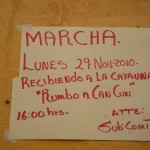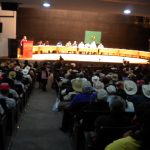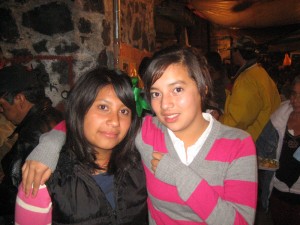 Global Exchange’s Carleen Pickard & other delegation members join fellow climate justice campaigners, environmentalists and social justice advocates from around the world for the COP16 in Cancun. They’re traveling with La Via Campesina organized caravans . En route to COP 16, the caravans are visiting communities in struggle and resistance, learning about the local effects of climate change and adding their voices of solidarity to communities working to construct a better future.
Global Exchange’s Carleen Pickard & other delegation members join fellow climate justice campaigners, environmentalists and social justice advocates from around the world for the COP16 in Cancun. They’re traveling with La Via Campesina organized caravans . En route to COP 16, the caravans are visiting communities in struggle and resistance, learning about the local effects of climate change and adding their voices of solidarity to communities working to construct a better future.
Ride along with Carleen and other caravan members as they share stories from the caravan to COP16. Next stop: Alpuyeca:
We join this chant no less than 100 times today. At any moment – a break in speakers, walking along a dusty road to a destination and in the 2 marches we participate in someone will start the call – (Zapata lives!) and everyone in earshot responds ‘la luuuuuucha vive!” (the struggle continues!). Repeat.
It’s a fitting chant for today. We arrive in the town of Alpuyeca and as we step off the bus, women step forward and toss confetti over our heads. 99 years ago the Plan de Ayala was signed here by revolution leader Emiliano Zapata at the end of the Mexican Revolution. We are positioned at the front of the crowd and lead a march into the town, celebrating the successes of this community.
A small girls begin: “Zaaaaaappppaatttaaaa viiiiiiiive!” and we respond. Recently this community has prevented their land from being expropriated for a new airport, stopped a significant highway expansion, blocked the highway in support of teachers protesting education ‘reform.’ Next we hear about the community’s largest victory – successfully closing a tremendous garbage dump.
 But first we enter the outdoor gathering area in a haze of copal and are treated to a Nahuatl welcoming, thanking the four points, the sky and tierra (land) for providing and keeping us safe. As hundreds of folks gather from the town, our hosts then invite speakers to the stage to talk about struggles in their communities. The caravan’s visit to Alpuyeca is a reason to gather and provides an important opportunity to bring the community together to talk of history, struggle, victory and resistance. Sharing our solidarity in this ‘tierra de Zapata’ feels appropriate as we see three, possibly four generations present and it’s clear that Zapata does live here.
But first we enter the outdoor gathering area in a haze of copal and are treated to a Nahuatl welcoming, thanking the four points, the sky and tierra (land) for providing and keeping us safe. As hundreds of folks gather from the town, our hosts then invite speakers to the stage to talk about struggles in their communities. The caravan’s visit to Alpuyeca is a reason to gather and provides an important opportunity to bring the community together to talk of history, struggle, victory and resistance. Sharing our solidarity in this ‘tierra de Zapata’ feels appropriate as we see three, possibly four generations present and it’s clear that Zapata does live here.
Local representatives take us to a large abandoned site in a residential neighborhood that once operated as a factory producing electrical transformers in the late ‘80s, before closing in 1990. It re-opened twice but was shut down  when workers fell ill. Very ill. Our guide reads out a horrifying list of illnesses reported – rashes, respiratory problems, auto immune infections, nervous system collapse, and pregnancy complications. When the site was finally investigated, a giant slurry of toxic waste was discovered to have been dumped in the basement and was seeping through the building and in the air. Also, toxic components of the electrical transformers were buried behind the building and after two decades they are surfacing to bake in the sun.
when workers fell ill. Very ill. Our guide reads out a horrifying list of illnesses reported – rashes, respiratory problems, auto immune infections, nervous system collapse, and pregnancy complications. When the site was finally investigated, a giant slurry of toxic waste was discovered to have been dumped in the basement and was seeping through the building and in the air. Also, toxic components of the electrical transformers were buried behind the building and after two decades they are surfacing to bake in the sun.
We stop at the closed garbage dump on our way out of the city, en route to Cuernavaca. The site is not much to look at: the giant pile of waste has been covered with earth from another location. A community activist tells us how the fight to close the dump united the community to say no to polluting their land with waste from Cuernavaca and yes to learning about recycling, reducing waste generation and “learning to change our bad habits.”
The Sindicato Mexicano de Electricistas (SME, the Mexican Electrical Workers), supporting Via Campesina through the caravans, are out hosts for the evening in Cuernavaca. Upon arrival we march through the streets to the zocalo (town square) and rally outside a palace built for the conquistador Cortez with stones taken from destroyed pyramids. In the rally that follows we hear testimony about the impacts of climate change on communities and frustration with the lack of solution based action from local, national and global leadership. The local SME representative and various other community leaders are joining the caravan tomorrow, while others have asked that we take their words with us to Cancun.
To close, Emiliano Zapata’s great grandson speaks – calling for unity in the struggle and that there is need to remember Zapata in these days. He says that with all of our collective effort we will be successful, save ourselves and the planet. Yes, Zapata vive – la lucha sigue.
Check back here on our Climate Justice blog to continue following Carleen’s journey. If you’re on Twitter, follow @globalexchange for related COP16 updates from Global Exchange, and use hashtag #COP16 for general COP16 tweets.








